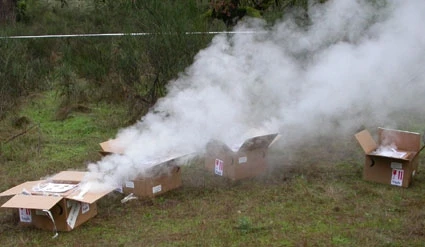December 20, 2003 Getting three square meals a day has a whole new meaning for American troops thanks to an innovative new package which provides everything necessary to feed up to 18 troops hot food in one small package. The Remote Unit Self Heating Meal (RUSHM), also referred to as "Kitchen in a Carton," takes the hassle out of serving hot food to warfighters in far away places.Developed by the Department of Defense Combat Feeding Directorate at the U.S. Army Soldier Systems Centre in Natick, Mass., the latest prototype of the remote meal reduces the carton's volume compared to previous prototypes by 20 percent by reconfiguring the package, trading larger dining trays for smaller ones, and swapping paper cups and beverage mixes for new resealable drink pouches.
"We've redesigned the whole module," said Lauren Milch, a physical scientist on the Equipment and Energy Team. 'Reduction in cube and weight is critical because these are designed for remote units that may have to carry it out to the field with them. It could be airdropped or taken by vehicle, but in the worst case, they're walking out with it. We're still on the heavy side, but it's carryable.'
Troops who don't have access to field kitchens, such as Signal units or Special Operations Forces, at best settle for hot food taken to them in thermal containers, only it's not always hot by the time the remote troops are located or are ready to eat the meal, said Milch. Kitchen in a Carton fills the vacant niche in remote feeding rations for small groups because the troops heat it themselves when they are ready to eat.
'Overall, it was very well-received,' said Peter Lavigne, a chemical engineer on the Equipment and Energy Team, referring to the latest RUSHM field evaluation with Rangers in Fort Lewis, Wash., in December 2003. 'It clearly met the needs of remote group feeding with minimal logistical support.'
Each 40-pound box contains four 6-pound polymeric Heat and Serve meal trays, with a main meal, entr'e, starch, vegetable and dessert stacked upon each other.
These trays, plus heating elements and activator, comprise what is called the heating module. Squeezed into two sides of the box are 18 drink packs providing 12-ounce servings of a flavoured beverage, 18 packages of candy, a serving spoon for each meal tray, a knife to slice open the tray lid, salt, pepper, a bottle of hot sauce, and18 dining trays and utensil packets with a fork, knife, spoon and napkin.
An instruction sheet is glued atop the heating module cover found within the outer carton. Within the heating module, each meal tray of food sits in a flameless ration heater tray activated when salt water saturates the chemicals. Ripping out a plastic tab that extends through the heating module cover breaks a plastic pouch of water at each level to start the heating process.
The heat of the shelf-stable tray rations is safely raised from 40 degrees to 140 degrees F in 30-45 minutes. A technical challenge in the package design is to make the activating water pouches strong enough to survive shipping and handling yet easy enough to tear open when desired, according to Milch. Another prototype uses an enclosed collapsible bottle containing salt that's filled with water and inserted into a tube on top when troops are ready to activate the heaters.
This further reduces the overall weight of the RUSHM since it does not contain the activation water, and would ensure performance by eliminating the possibility of accidental activation during shipping and handling, according to Milch. 'The Soldiers liked having time to do other activities while the trays were heating,' Milch said about feedback from the latest evaluation.
She said they also liked having everything in one box, the number of servings provided per box, the remote meal's size and weight, and the new drink packs, which are also being considered for use in other rations developed by Combat Feeding. User suggestions for improvements included providing individual hot sauce bottles, a trash bag for food waste, wet napkins, slotted spoons and bread.
Now in the advanced development stage, the project has matured to the point that the team is working on creating menus, Milch said. Four varieties were available for the technical demonstration, but selections will expand to reflect menus similar to the Unitized Group Ration Heat and Serve.
Another demonstration is scheduled for this year to gather more data. Other potential changes include the use of group-serving pouched foods as an alternative to tray rations, which could be packaged in three pouches instead of four trays to further reduce weight, she said. "It's another option, and pouches heat more efficiently than the trays, which could further reduce the amount of activation water and chemical heater material needed," Milch said. "We're also testing a new type of flameless ration heater that's safer and more environmentally preferable."
The RUSHM could be available as soon as 2006.









